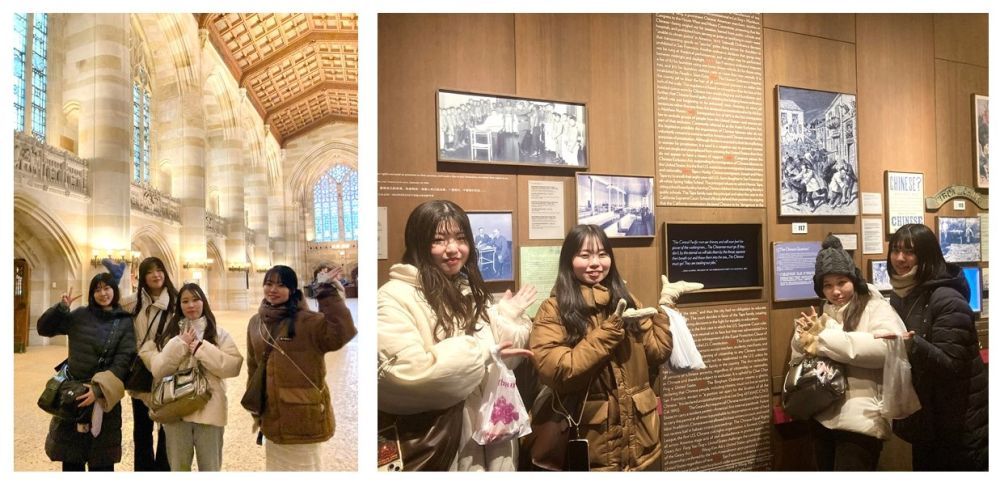2025.03.07
News
Global Study Trip on US History and Culture by Students of Faculty of Commerce
The Faculty of Commerce offers a distinctive global education program, “Global Fields Studies,” conducted as part of year-long research seminars.
Students from the “Global Liberal Arts Seminar (Professor Yuki Oda)” at the Faculty of Commerce visited New York from January 29th to February 6th, 2025, to explore the actual conditions of the history and cultures of America. * The travel expenses for this study trip were partially covered by the “Distinctive Faculty Education Aid” provided by the Faculty of Commerce, Chuo University.
The Global Liberal Arts Seminar aims to develop students’ ability to collaborate with individuals from diverse linguistic and cultural backgrounds in the future. We believe this is achieved by deepening their understanding of global languages, history, and cultures, as well as studying related businesses and social activities.

Study Report
Purpose of the Study Trip
The study trip concluded our year-long seminar at Tama Campus, where we explored American history and culture spanning from colonial times to today. In the spring semester, we read a book on the intellectual and religious history of the U.S. In the fall seminar, each student wrote a seminar paper on a topic of their interest. On this study trip, we traveled to New York and its nearby regions, concentrating on two themes: firstly, the establishment of immigrant communities in urban settings, and secondly, the university's role as a community and fostering a collaborative relationship between the university and the local community.
Findings
-Immigrant communities in urban areas-
New York stands as a leading global city for immigrants, with nearly one-third of its 8.8 million residents born outside the U.S. American-born children of immigrant parents now make up more than half of all newborns in the city. On this research trip, we focused on the swift expansion of the Chinese community, which is the second largest after the Dominican population. The origins of Chinese immigrants in New York can be traced back approximately 180 years. Currently, there are nine distinct Chinatowns across the city, some with long-established histories and others thriving with more recent immigrants.
We explored the oldest Chinatown in Lower Manhattan, established in the 19th century. This vibrant area showcases the rich histories of Chinese immigrants who settled here from different times and places. Unlike the nearby Little Italy, which has seen a decline due to reduced Italian immigration, Chinatown remains vibrant and thriving. We examined various buildings and signs throughout the neighborhood to understand the progression of ethnic businesses and mutual aid organizations. Our day concluded with a visit to the Museum of Chinese in America, inaugurated in 1980. The historical exhibits offered us valuable insights into the evolution of Chinese American communities from the 19th century to the present. In the context of an increasingly globalized world, the field trip prompted us to reflect on the opportunities and possibilities that immigrants can bring to Japan.
-University as a community and university within the local community-
A few hours by train from New York, we visited Yale University in New Haven, Connecticut. Founded in 1701, Yale is one of the oldest universities in the U.S. One of Yale’s distinctive features is its college system, which is based on those in England. Freshmen to seniors live together within their respective colleges, making these colleges the central community of campus life. We learned how Yale’s colleges foster a sense of community for students from diverse backgrounds. Diversity was not always a part of Yale. For example, it wasn't until the late 1960s that Yale began admitting female students. The majority of students were once predominantly white and Protestant. However, that is a feature of the past. Today, Yale promotes diversity in many aspects, from its admission process to the distribution of students from various majors and backgrounds within each college.
Although the university fosters a strong sense of community, establishing a closer bond with the local community presents a challenge. Yale stands as a top private university in the U.S., with many of its students coming from wealthy families. In sharp contrast, New Haven has a high poverty rate, with 25% of its residents living below the poverty line. This ratio is twice the national average. A significant disparity exists in this mid-size city with a population of 135,000. To address these issues, Yale offers programs for local public school students, employs residents to work at the university, and stimulates the local economy through university-originated startups. The study trip inspired us to consider the role of universities in local communities and the roles that Chuo University should assume.
